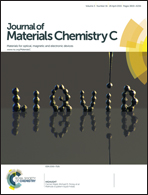Tunable wide blue photoluminescence with europium decorated graphene†
Abstract
The current paper describes europium decorated graphene (EuG) which provides high and wide blue emission at 400 nm and 458 nm. The chemical and structural properties of the products are characterized using X-ray photoelectron spectroscopy (XPS), X-ray diffraction (XRD), Raman spectroscopy and transmission electron microscopy. Fourier transform infrared (FT-IR) and UV–Vis spectrometery are employed to analyze the optical properties. The photoluminescence features are investigated using the excitation/emission spectra and fluorescence microscopy images. The photoluminescence intensity of EuG with the bright fluorescent nature of europium is higher than that of reduced graphene oxide. The transition of trivalent europium (Eu3+) that leads to the radiation of light with a 590 nm wavelength can be turned into a 4f–4f transition of divalent (Eu2+) europium upon heating in the presence of the graphene sheet, which assists the reduction of the europium ion. The enhancement of the blue emission at 458 nm with quenching in the red at 590 nm is affected by the modification of properties (by → via) the europium–graphene composite concentration and external thermal energy. The result suggests a new possibility for the fluorescence characteristics of the lanthanide–graphene nanocomposite that can be applied to the display, optoelectronic devices, and bio-imaging fields. The temperature-tunable photoluminescence characteristics can be used as a non-contact thermal sensor.


 Please wait while we load your content...
Please wait while we load your content...